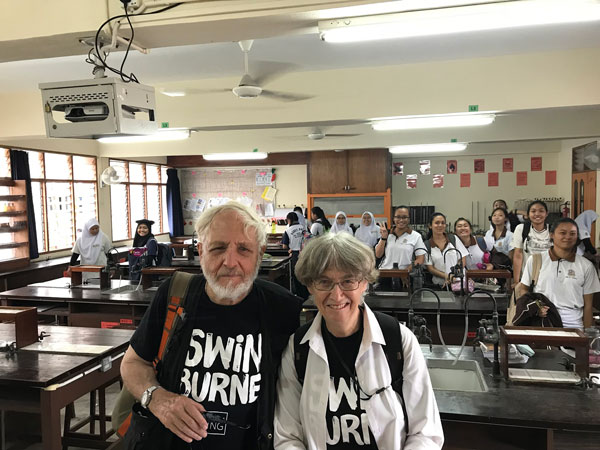KUCHING – Students of SMK St Teresa Kuching and Tunku Putra School were in for a treat when two distinguished palaeontologists from Australia delivered talks at their schools recently.
Professor Patricia Vickers-Rich from Swinburne University of Technology and her husband Dr Thomas H. Rich, curator of Palaeontology at the Melbourne Museum, spoke to the school students on the topic ‘What can capture imagination better than dinosaurs?’, and shared their many years of experience and challenges as palaeontologists where it involves the scientific study of plant and animal fossils.
They opined that such school visit is important to bring to students the latest discoveries in palaeontology and how it relates to planning our future.

Palaeontologists Vickers-Rich and Rich at the end of their talk at SMK St Teresa.
Vickers-Rich, who holds a professorship in palaeobiology, currently teaches at undergraduate level and mentors graduate student projects at Swinburne University of Technology. She is also the Honorary Director of PrimeSCI, a pre-tertiary science education group at the university. PrimeSCI provides outreach science education programmes for primary and secondary school students, as well as professional development for teachers with the aim to enrich understanding of science and technology.
Meanwhile, Rich’s interests are about our very ancestors, ancient tiny animals that lived more than 125 million years ago. Both are involved in exploration and frequently travel to attend science exhibitions in different parts of the world.
These palaeontologists are no strangers to Kuching. Last year, they were invited to give a public talk entitled ‘Chasing Butterflies and Other Unknowns: The Work of AR Wallace and his local technician Ali’ in conjunction with the What About Kuching (WAK) event. During her visit, Vickers-Rich also took the opportunity to hike Mount Sadong and Mount Santubong to explore the biodiversity in those areas along with Tom McLaughlin and his family.
Vickers-Rich has written a number of research and popular books which have won awards including the Premier of Victoria’s Science book of the year and two Eureka awards, as well as published more than 200 scientific publications, including several in Science along with Rich over the years.
Commenting on her vision for the future generations, Vickers-Rich hopes that we can learn what worked and failed in the past to avoid making the same mistakes in the future, and make our earth sustainable and truly enjoyable to live in.
For more information about Swinburne’s Sarawak campus, visit the university’s website (www.swinburne.edu.my), Facebook page (@swinburnesarawak), Instagram (@swinburnesarawak), Twitter page (@Swinburne_Swk) or YouTube channel (Swinburne Sarawak).


